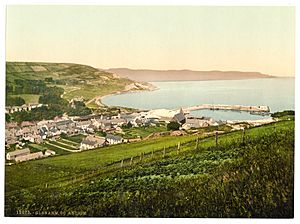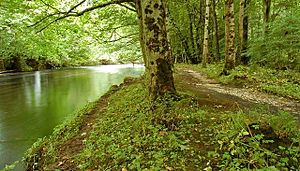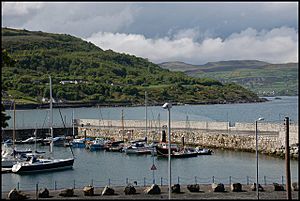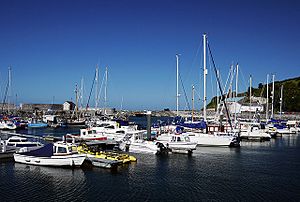Glenarm facts for kids
Quick facts for kids Glenarm
|
|
|---|---|
 Glenarm Bay |
|
| Population | 568 (2011 Census) |
| • Belfast | 25 mi (40 km) |
| District |
|
| County | |
| Country | Northern Ireland |
| Sovereign state | United Kingdom |
| Post town | BALLYMENA |
| Postcode district | BT44 |
| Dialling code | 028 |
| Police | Northern Ireland |
| Fire | Northern Ireland |
| Ambulance | Northern Ireland |
| EU Parliament | Northern Ireland |
| UK Parliament |
|
| NI Assembly |
|
Glenarm is a village in County Antrim, Northern Ireland. Its name comes from the Irish words Gleann Arma, meaning "valley of the army."
Glenarm is located on the coast of the North Channel, which is a sea strait. It sits north of the town of Larne and south of the village of Carnlough. The village is part of the Mid and East Antrim Borough Council. In 2011, about 568 people lived there. Glenarm is special because it's in the southernmost of the nine famous Glens of Antrim.
Contents
History of Glenarm
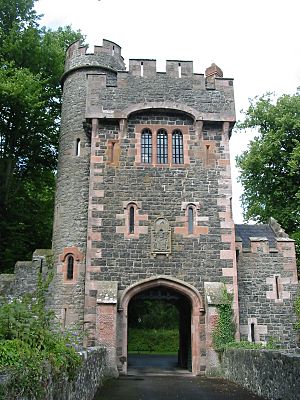
Glenarm is thought to be the oldest town in Ulster, a province in Ireland. It received an important document called a charter in the 12th century. This charter gave the town special rights.
The main castle in Glenarm dates back to 1750. It was changed and improved in the early 1800s. The Barbican Gate, which is a grand entrance to Glenarm Castle, was fixed up by a group called the Irish Landmark Trust. This group helps save old buildings that might otherwise be lost.
Early Settlements and Kingdoms
Between the 400s and 600s AD, Glenarm was part of a kingdom called Dal Riada. This kingdom stretched along the coast of County Antrim. Another group of tribes, the Dal nAraide, lived south of Glenarm. A part of the Dal nAraide, called Latharna, lived along the coast from Glenarm down to Carrickfergus.
Around this time, the Vikings also came to the area. They set up a settlement at "Ulfrek's fjord," which is now the town of Larne. An Icelandic historian named Snorri Sturluson wrote that an Irish king defeated the Vikings there in 1018.
Glenarm's First Castles
The first castle in Glenarm was mentioned in records from 1270. It was likely built even earlier by a family called the de Galloways. This first castle was located where a Baptist church stands today.
In the early 1600s, after a long period of conflict, new settlers from Great Britain came to Ulster. This was part of a plan called the Plantation of Ulster. In 1603, Sir Randall MacDonnell, a local leader, convinced King James I to give him control of the Glens of Antrim.
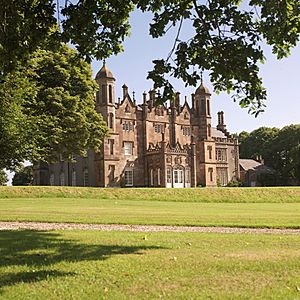
A new castle was then built in Glenarm. It was on the opposite side of the river from the old one, on the site of the current Glenarm Castle. This new castle was improved until Sir Randal MacDonnell died in 1636. The old castle was also used for some time.
Conflicts and Rebuilding
During the Irish Rebellion of 1641, Alexander MacDonnell, who lived in Glenarm, joined the Irish side. He gathered soldiers who stayed in Glenarm. In 1642, a Scottish army attacked and burned Glenarm, including the new castle. Alexander and his brother were captured.
After the fighting ended, the MacDonnells got their land back. However, they did not rebuild the castle in Glenarm right away. They moved to other castles instead.
In the 1700s, Lord Antrim returned to Glenarm. With his help, many new buildings were constructed. A new castle was built over the ruins of the one destroyed in 1642. This castle, built in 1756, is the main part of the castle you see today. In 1763, St. Patrick's Church of Ireland was built on the site of an old Franciscan monastery.
Glenarm During the Famine
During the Great Irish Famine (1845-1849), the Glens of Antrim did not suffer as much as other parts of Ireland. The Earl of Antrim and another important leader, the Marquess of Londonderry, helped their tenants. They provided food and money and set up soup kitchens. Glenarm's soup kitchen was likely behind Altmore Street.
In 1854, a serious illness called cholera spread through Glenarm. Many people in the town got sick. Those who died were buried in a large grave near St. Patrick's Church.
Places to Visit in Glenarm
Glenarm Forest Park is a large nature area, about 800 acres in size. It used to be part of the Glenarm Castle estate. Now, it's open to the public and looked after by the Ulster Wildlife Trust. Other interesting places include a salmon fishery and the famous Glenarm Castle.
Sports in Glenarm
Glenarm has several successful sports teams. The Glenarm Rowing Club is very active. They train in the summer for an annual all-Ireland rowing competition. In 2009, their Veteran Team won a silver medal. The club has been around since the late 1800s and is popular today. They often have races with other local rowing clubs.
There is also a football team called Glenarm Rovers F.C. They play on Saturday mornings.
Shane O'Neills GAA Club is located just outside Glenarm. They have teams for the Irish sport of hurling at different age levels.
Events and Festivals
- Highland Games tournaments are often held at Glenarm Castle. These games include traditional Scottish sports and activities.
- The Glenarm GAA club hosted the North Antrim Feis in 2009. This is a gathering that celebrates Irish culture. It includes sports finals, art contests, and traditional performances.
- The Dalriada Festival also takes place at Glenarm Castle and in the village. This festival celebrates sports, music, and food from Scotland and Ireland. It also features traditional Ulster Scots cultural events.
- As part of the Dalriada Festival, Glenarm Castle has started hosting large outdoor concerts. Famous artists have performed there.
- Summer Madness, which is Ireland's biggest Christian Festival, moved to Glenarm Castle in 2012. It is expected to return there every year.
Glenarm as a Film Location
Glenarm village has been used as a setting for movies and TV shows.
- The film The Boys from County Clare (2003) used Glenarm and other places in the Glens of Antrim.
- Glenarm Castle itself was featured in Five Minutes of Heaven.
- Scenes for the Christmas movie A Christmas Star were filmed near Glenarm's marina.
- The BBC drama My Mother and Other Strangers used Altmore Street to look like a WWII setting.
- The popular American TV series Game of Thrones also used Glenarm's beautiful scenery in some of its episodes.
Population Information
Glenarm is considered a small village by the Northern Ireland Statistics and Research Agency (NISRA). This means it has fewer than 1,000 people.
On March 27, 2011, a census showed that 568 people lived in Glenarm.
- About 21% of the people were under 16 years old.
- About 17% were aged 60 or older.
- About 47% of the population were male, and 53% were female.
- About 43% of people said they were from a Catholic background.
- About 53% of people said they were from a Protestant background.
Images for kids
See also
 In Spanish: Glenarm para niños
In Spanish: Glenarm para niños




